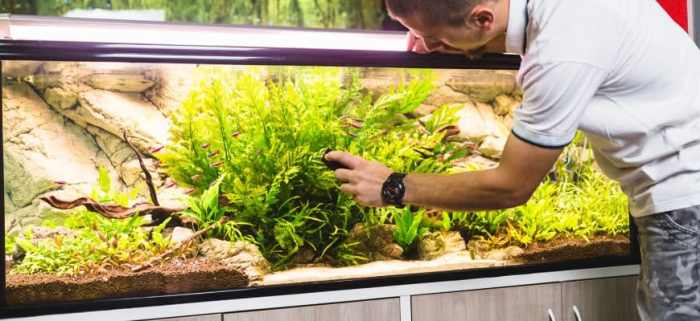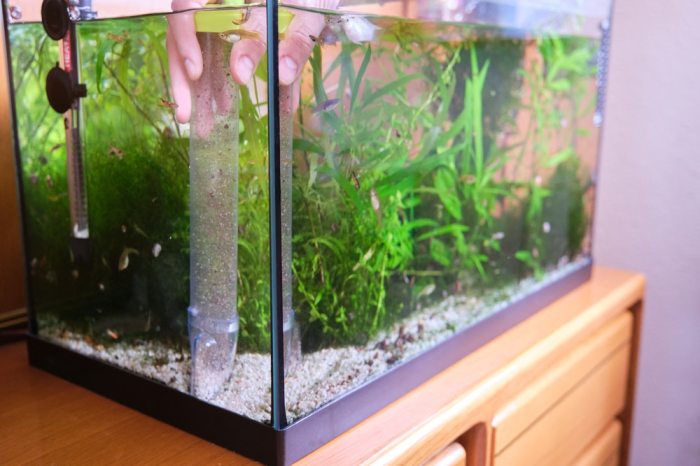Can I put vinegar in my fish aquarium? This question sparks curiosity among aquarium enthusiasts, as vinegar is a common household item with potential applications in aquarium maintenance. This guide delves into the effects of vinegar on fish, explores its uses and alternatives, and provides practical considerations for its safe application in aquariums.
Understanding the Effects of Vinegar on Fish

Vinegar, a household staple, is a versatile liquid with various applications. However, its use in aquariums requires careful consideration due to its potential impact on fish physiology.
Vinegar primarily consists of acetic acid, a weak organic acid. When added to an aquarium, it can alter the water chemistry, potentially affecting fish health. Understanding the effects of vinegar on fish is crucial before using it in an aquarium setting.
Chemical Composition and Impact, Can I put vinegar in my fish aquarium
Acetic acid, the main component of vinegar, is a weak acid that can dissociate into hydrogen ions (H+) and acetate ions (CH3COO-) in water. The addition of vinegar to an aquarium lowers the pH of the water, making it more acidic.
Fish have evolved to tolerate a specific pH range, and sudden changes in pH can cause stress, disrupt their metabolism, and damage their gills. Extreme pH fluctuations can even lead to death.
Potential Risks and Benefits
Adding vinegar to an aquarium can have both potential risks and benefits, depending on the concentration and frequency of use.
- Risks:Excessive or frequent use of vinegar can lead to pH imbalances, causing stress, metabolic disruption, and gill damage in fish. It can also be toxic to certain fish species, particularly those sensitive to acidic environments.
- Benefits:In small, controlled doses, vinegar can have beneficial effects in an aquarium. It can act as a mild disinfectant, helping to control bacterial and fungal growth. Additionally, it can aid in the removal of algae and biofilm from aquarium surfaces.
Fish Species Sensitivity
Different fish species exhibit varying levels of tolerance to vinegar. Some species, such as tetras and discus, are highly sensitive to pH changes and may not tolerate even small amounts of vinegar. Others, like cichlids and catfish, are more tolerant and can withstand higher vinegar concentrations.
It is essential to research the specific fish species in your aquarium before adding vinegar. If you are unsure about the tolerance of your fish, it is best to err on the side of caution and avoid using vinegar.
Dosage and Application of Vinegar: Can I Put Vinegar In My Fish Aquarium
Determining the appropriate concentration of vinegar for your aquarium is crucial to ensure the well-being of your fish. The optimal concentration depends on the size of your aquarium and the species of fish you keep. As a general guideline, use the following concentrations:
- For aquariums up to 10 gallons: 1 tablespoon of vinegar per 5 gallons of water
- For aquariums between 10 and 20 gallons: 1 tablespoon of vinegar per 10 gallons of water
- For aquariums over 20 gallons: 1 tablespoon of vinegar per 20 gallons of water
To add vinegar to your aquarium, dilute it in a separate container with water before adding it to the main tank. This helps prevent sudden pH changes that can shock your fish. Start by adding half of the recommended dosage and gradually increase it as needed.
Monitor your pH levels regularly and adjust the vinegar dosage accordingly to maintain a pH between 6.5 and 7.5.
Alternatives to Vinegar for Aquarium Maintenance

Vinegar is a popular choice for aquarium maintenance due to its acidity and antibacterial properties. However, there are other natural and chemical substances that can be used for cleaning and pH adjustment.
These alternatives vary in effectiveness and safety, and some may be more suitable for specific aquarium conditions. Here’s a comparison of some common alternatives to vinegar:
Baking Soda
- Effectiveness:Baking soda can neutralize acids and increase pH, making it useful for raising the pH of acidic aquariums.
- Safety:Baking soda is generally safe for fish and plants in small doses.
- Pros:Easy to use and inexpensive.
- Cons:Can cause a temporary increase in pH, which can be stressful for fish.
Sodium Bicarbonate
- Effectiveness:Similar to baking soda, sodium bicarbonate can raise pH and buffer water chemistry.
- Safety:Sodium bicarbonate is generally safe for fish and plants.
- Pros:Effective at stabilizing pH and preventing pH swings.
- Cons:Can be more expensive than baking soda.
Lemon Juice
- Effectiveness:Lemon juice contains citric acid, which can lower pH and dissolve mineral deposits.
- Safety:Lemon juice can be harmful to fish if used in large quantities.
- Pros:Natural and inexpensive.
- Cons:Can lower pH too much if not used carefully.
Long-Term Effects of Vinegar on Aquarium Ecosystems
While vinegar can be beneficial for short-term aquarium maintenance, prolonged use may have detrimental effects on the ecosystem.
Impact on Beneficial Bacteria
Vinegar can disrupt the balance of beneficial bacteria in the aquarium. These bacteria play a crucial role in the nitrogen cycle, converting toxic ammonia and nitrites into less harmful nitrates. Extended exposure to vinegar can kill or inhibit the growth of these beneficial bacteria, leading to an accumulation of harmful compounds in the water.
Can I put vinegar in my fish aquarium? Before you add vinegar to your fish tank, it’s important to consider whether vinegar is harmful to fish. Is vinegar harmful to fish ? Read more to learn about the potential effects of vinegar on your aquatic pets and determine if it’s a suitable additive for your fish aquarium.
Effects on Other Organisms
Vinegar can also harm other organisms in the aquarium, including plants, snails, and shrimp. It can cause damage to plant leaves, kill snails, and inhibit the growth and reproduction of shrimp. The acidity of vinegar can also alter the pH balance of the water, making it unsuitable for some species.
Monitoring and Mitigation
To mitigate the negative effects of prolonged vinegar use, it’s essential to monitor the health of fish and other aquatic life. Regular water testing can help detect changes in pH, ammonia, nitrite, and nitrate levels. If negative effects are observed, gradually reduce the frequency and concentration of vinegar treatments or consider alternative methods for aquarium maintenance.
Practical Considerations for Using Vinegar in Aquariums

Using vinegar in aquariums requires careful consideration and adherence to specific guidelines. To ensure the safety and well-being of your fish, follow these practical steps and recommendations.
Step-by-Step Guide for Safely Adding Vinegar to an Aquarium
- Determine the appropriate vinegar concentration:Refer to the table below for recommended concentrations based on aquarium volume and pH level.
- Test the vinegar solution:Dilute the vinegar solution to the desired concentration and test its pH using a pH meter. Adjust the solution as needed to achieve the target pH.
- Add the vinegar solution gradually:Add the vinegar solution to the aquarium slowly, monitoring the pH level and fish behavior closely. Do not add more than 10% of the total aquarium volume at a time.
- Monitor the aquarium closely:Observe the fish for any signs of stress or discomfort. If any adverse reactions occur, immediately remove the vinegar solution and perform a water change.
Recommended Vinegar Concentrations for Different Aquarium Volumes and pH Levels
| Aquarium Volume (gallons) | pH Level | Vinegar Concentration (ppm) |
|---|---|---|
| 10 | 7.0-7.5 | 100-150 |
| 20 | 7.0-7.5 | 50-100 |
| 50 | 7.0-7.5 | 25-50 |
| 100 | 7.0-7.5 | 10-25 |
Troubleshooting Common Issues
- Fish appear stressed or uncomfortable:Immediately remove the vinegar solution and perform a water change. Monitor the fish closely for any signs of distress.
- pH level drops too low:Gradually add baking soda to the aquarium to raise the pH level. Monitor the pH level closely and adjust as needed.
- Vinegar smell persists:Perform a water change to remove the vinegar smell. Use activated carbon in the filter to absorb any remaining odor.
Final Wrap-Up

In conclusion, using vinegar in aquariums requires a balanced approach, considering its potential benefits and risks. By understanding the effects of vinegar on fish, following recommended dosages, and monitoring water parameters, aquarium owners can harness the power of vinegar for targeted aquarium maintenance while ensuring the well-being of their aquatic inhabitants.
Question & Answer Hub
Can I use any type of vinegar in my aquarium?
White vinegar (5% acetic acid) is the recommended type for aquarium use due to its low acidity.
How often can I add vinegar to my aquarium?
For pH adjustment, add vinegar gradually over several days. For cleaning purposes, use it sparingly and only when necessary.
What are the signs of vinegar overdose in fish?
Rapid breathing, lethargy, and loss of appetite can indicate vinegar overdose. Adjust the pH immediately by performing water changes.
